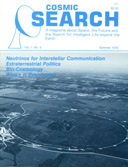![[NAAPO Logo]](../../Images/NAAPOsm.jpg) North American AstroPhysical Observatory (NAAPO)
|
|
Letters
By: Editors
I would like to express congratulations on developing a journal that I feel is of the first magnitude.
Each Planetarian throughout the world who is a member of the International Planetarium Society should be given the opportunity to subscribe to your fine journal.
Speaking as a person with no scientific training, but with great curiosity about the universe and what lies out there, I find your magazine enthralling.
How wonderful it was to receive your first issue! It seems to me such a magazine is essential to bridging the gap between research and the public. Congratulations and best wishes for a successful venture!
I want to congratulate you on the fine quality of the premier issue of COSMIC SEARCH. I never before read any magazine from cover to cover. I not only did so with COSMIC SEARCH but did it twice. I will be looking forward to many more interesting articles in future issues of COSMIC SEARCH.
I was really looking forward to the first issue of your magazine and I was not let down as I enjoyed it very much. In fact I read every word in it before I put it down.
Thank you for your fine article, "ABCs of SETI", in the March issue of COSMIC SEARCH. The section on broadband and narrowband signals was excellently done and was long overdue in the astronomy periodicals.
Thank you for the first issue of COSMIC SEARCH. It is wonderful to see it actually come off the press as you said it would, rather than six months late as most new magazines do.
After having read the entire issue I can say that you have put together a fine journal, with a very good Editorial Board. It was a pleasure to read and long overdue.
Bach or Beethoven?
May I comment on the small item in the March issue:
If a production of the sonic arts of northwestern Europe were to strike a familiar chord in a culture that faces the challenges of interstellar space, I feel sure that it would be an opus of Beethoven. The music of Bach, sublime though it is, is an expression of a people who had gained an illusion of mastery over their environment, while we, two centuries afterwards,
know that this mastery does not extend to a universe so awesomely unhuman. Only now do our arts have access to an awareness that could be common to other beings who know the vastness of interstellar space.
Correction
The SEnTInel item in the March 1979 COSMIC SEARCH about the National Radio Astronomy Observatory (NRAO) interferometer is incorrect to the extent that it implied that the Navy had taken over the interferometer.
Hein Hvatum, Associate Director of NRAO, writes: "The Associated Universities, Inc., is still operating NRAO in Green Bank, West Virginia, with all its telescopes and facilities, including the 2700 meter three-element interferometer. However, the
Navy is presently funding the interferometer operation for one year in order to test the feasibility of using a radio telescope interferometer for the time service."
"The invariable mark of wisdom is to see the miraculous in the common."
Ralph Waldo Emerson
|

